What Was Your Original Face on Mars?—Zen and the Prophetic Sublime
Saturday, 11 February, 2017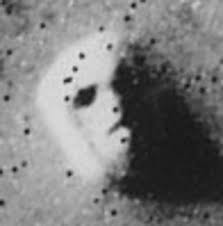
The famous “Face on Mars,” first photographed by the Viking orbiters in 1976, was the object of much speculation in the 1980s and 1990s and continues to be. After it was identified by Richard C. Hoagland, the Face became the central icon in a narrative of ancient global destruction—perhaps nuclear war—that, some suggested, may have tragically rendered our nearest cosmic neighbor a dead world, aeons in the past. The Face, staring out at the universe, seemed like it could be both a monument and a warning to our species … if it was a face.
The Face on Mars was eminently psi-worthy. Multiple artists’ encounters with this haunting image seem to have rippled back in time.
Later NASA photographs (such as the one below) revealed greater erosion, less symmetry, and a much less human visage than Viking’s low-res cameras; it’s not a face at all, most now agree, just an oddly eroded mesa. Yet what matters for me is the meme, the haunting idea sparked by those original pictures, which captured the imagination not only of the public but also of many scientists for years.
 Even the ever-skeptical Carl Sagan felt the Face deserved study, having himself always suggested the possibility that we might find alien ruins in our solar system. Although he distanced himself from wilder speculations about the feature, the dreadful possibility of a civilization destroying itself in a nuclear war was one that was close to his heart as a disarmament activist; it also happened to be Mars’s dust storms that gave him his first model of “nuclear winter.” Later writers like Mac Tonnies and physicist John Brandenburg elaborated on the ideas of a Martian apocalypse in prehistory, and the Mars Anomaly community retains a belief that the Face is artificial and that NASA and/or its contractors have manipulated later images to make it look otherwise.
Even the ever-skeptical Carl Sagan felt the Face deserved study, having himself always suggested the possibility that we might find alien ruins in our solar system. Although he distanced himself from wilder speculations about the feature, the dreadful possibility of a civilization destroying itself in a nuclear war was one that was close to his heart as a disarmament activist; it also happened to be Mars’s dust storms that gave him his first model of “nuclear winter.” Later writers like Mac Tonnies and physicist John Brandenburg elaborated on the ideas of a Martian apocalypse in prehistory, and the Mars Anomaly community retains a belief that the Face is artificial and that NASA and/or its contractors have manipulated later images to make it look otherwise.The Face on Mars “meme complex” falls into a very specific aesthetic-psychological category, that of the sublime. The sublime was named by philosophers and aestheticians in the 18th Century (like Immanuel Kant, Edmund Burke, and Joseph Addison) to describe the specific feeling evoked by works of art that suggest immensity and destruction. Towering thunderclouds and storms at sea, scenes of massive destruction on a Biblical scale, and wild landscapes with ruins in them all fit into this category. (Originally, the sublime was elevated above the merely beautiful as something that mainly men were able to savor and enjoy; the ‘weaker sex’ was believed to prefer pleasant domestic scenes, flowers, and other images that were not so existentially challenging.)
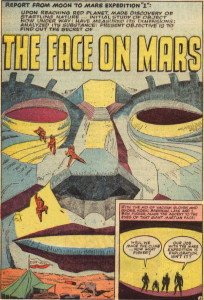 The sublime is highly relevant to psi, I believe. It happens to be precisely these kinds of sublime scenes and situations—including fires, shipwrecks, natural disasters, and haunted ruins in a dead landscape—that have always dominated people’s spontaneous accounts of ESP experiences. The many dreams and prophecies of the Titanic or 9/11 are examples, as are many of the “phantasms of the living” catalogued by the Society for Psychical Research in the 1880s. Thus it is not surprising that at least two prominent artists notably seem to have precognized the Face on Mars, the most famous “space ruin.” The best known, thanks in large part to Chris Knowles, is comic artist Jack Kirby, who wrote and illustrated a story called “The Face on Mars” in 1958—in which astronauts to the Red Planet explore a massive stone face and one of them receives a mind-transmission hologram showing the interplanetary war that laid waste the planet long ago. Kirby not only “saw” the face, in other words, but the whole meme-complex that formed around it (ancient planetary war and destruction).
The sublime is highly relevant to psi, I believe. It happens to be precisely these kinds of sublime scenes and situations—including fires, shipwrecks, natural disasters, and haunted ruins in a dead landscape—that have always dominated people’s spontaneous accounts of ESP experiences. The many dreams and prophecies of the Titanic or 9/11 are examples, as are many of the “phantasms of the living” catalogued by the Society for Psychical Research in the 1880s. Thus it is not surprising that at least two prominent artists notably seem to have precognized the Face on Mars, the most famous “space ruin.” The best known, thanks in large part to Chris Knowles, is comic artist Jack Kirby, who wrote and illustrated a story called “The Face on Mars” in 1958—in which astronauts to the Red Planet explore a massive stone face and one of them receives a mind-transmission hologram showing the interplanetary war that laid waste the planet long ago. Kirby not only “saw” the face, in other words, but the whole meme-complex that formed around it (ancient planetary war and destruction).  Slightly less well known—at least among anomalists and ancient-astronaut enthusiasts—is the Japanese-American sculptor Isamu Noguchi. In 1947, almost three decades before the Face was imaged by Viking, Noguchi created a one-foot-square sand model for an earthwork called “Sculpture to be seen from Mars” and took a photograph of his model. All we now have is that photo, and it looks uncannily like Viking’s photograph, including the tilt at which it appears in the artist’s photo. The proposed dimensions of the earthwork, to be built in some “unused area” like a desert, are of a similar scale (Noguchi’s face was to be ten miles long, its nose a mile in height; the actual “Face” mesa in the Cydonia region on Mars is a little over a mile long). But more uncanny than the physical resemblance is the purpose of Noguchi’s earthwork: to signal the human presence to the cosmos in the aftermath of our species’ demise in a nuclear holocaust. It was, Noguchi said, “a requiem for all of us who live with the atom bomb.” At the time, following the destruction of two Japanese cities by such weapons, Noguchi worried that a world-destroying conflict was inevitable.
Slightly less well known—at least among anomalists and ancient-astronaut enthusiasts—is the Japanese-American sculptor Isamu Noguchi. In 1947, almost three decades before the Face was imaged by Viking, Noguchi created a one-foot-square sand model for an earthwork called “Sculpture to be seen from Mars” and took a photograph of his model. All we now have is that photo, and it looks uncannily like Viking’s photograph, including the tilt at which it appears in the artist’s photo. The proposed dimensions of the earthwork, to be built in some “unused area” like a desert, are of a similar scale (Noguchi’s face was to be ten miles long, its nose a mile in height; the actual “Face” mesa in the Cydonia region on Mars is a little over a mile long). But more uncanny than the physical resemblance is the purpose of Noguchi’s earthwork: to signal the human presence to the cosmos in the aftermath of our species’ demise in a nuclear holocaust. It was, Noguchi said, “a requiem for all of us who live with the atom bomb.” At the time, following the destruction of two Japanese cities by such weapons, Noguchi worried that a world-destroying conflict was inevitable. So here again, an artist seems to have prophesied not only a famous object/photograph but also the sublime meme complex surrounding it—although in Noguchi’s version, Mars and Earth swapped roles.
Noguchi was still alive and active in 1976, and right up to his death in 1987. He was intensely interested in science and technology all his life, including both nuclear weapons and space exploration; one of his last works, for instance, was a Miami monument to the astronauts killed in the Challenger disaster. So there is no doubt in my mind that he would have been aware of and interested in the Viking missions as well as the resurgent concerns about nuclear war during the Reagan era, when the “Face on Mars as remnant of a destroyed Martian civilization” meme took shape. My regular readers will know that I think precognition centers on future exciting encounters and learning experiences during an individual’s lifetime. Kirby too was still alive and active at the time of the Viking missions and through the 1980s, dying in 1994 (and his comic would not have been influenced by Noguchi’s proposed sculpture, since the latter only existed in a single unpublished photograph).
The Sublime Semiotics of Prophecy
The sublime, or aesthetic pleasure in signs of destruction, is essentially identical to the Lacanian notion of jouissance and to the older Freudian notion of “death drive.” It was Freud who most brilliantly theorized these childhood roots of the sublime. In his book Beyond the Pleasure Principle, Freud described watching his toddler nephew repeatedly throwing a spool over the side of his crib and exclaiming “fort” (gone), then pulling it back and enjoying its return, “da” (there), and then doing the same thing with his own reflection in a mirror. Playing with loss and recovery as a way of conceptually mastering the idea of nothingness/annihilation. Paintings of sublime scenes stage this same pleasure at annihilation-and-return, losing and finding again, but on a grander scale.
This sense of “but I survived” is the basis of the sublime, the semiotic language of prophecy.
As I argued in the context of Thomas Pynchon’s prescient-about-prescience novel Gravity’s Rainbow (about an American officer whose sexual response anticipates V2 strikes during the Blitz), the “psi reflex” really orients to rewards, not only sexual rewards (as in Daryl Bem’s and Dean Radin’s presentiment experiments involving erotic pictures) but also the reward of surviving some chaotic or entropic threat. Although psychical phenomena and ESP have always been linked to “trauma,” this notion masks the fact that they really seem to key in on signals of survival: Implicitly, if you’re traumatized, then you’ve survived. If psi, as precognition, is a biological function, it has to have emerged and prevailed as an adaptive trait, orienting the organism toward its own future survival/reproduction or that of its kin.
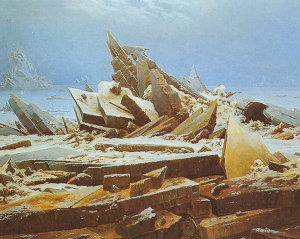 This sense of “but I survived” is the basis of the aesthetic sublime: Enjoyment of the fact that I’m still here, even amid these signs of ruin. It is why the sublime perfectly describes the semiotic language of prophecy. Some of those on the Star Gate remote viewing project, such as Edwin May and Dale Graff, have argued that our psi faculty keys in on actual entropy gradients like fires, explosions, and nuclear reactions. The accuracy of remote viewers when assigned such targets is a crucial fact, but it misses the important point that signs of entropy in the past, or symbols of entropy that never really existed, may be just as vivid to our psi eyes as the real thing.* I suspect psi, as precognition, is a fundamentally semiotic phenomenon, involving a sensitivity to associatively encoded information refluxing from the brain’s own future and not entropic ripples through spacetime.
This sense of “but I survived” is the basis of the aesthetic sublime: Enjoyment of the fact that I’m still here, even amid these signs of ruin. It is why the sublime perfectly describes the semiotic language of prophecy. Some of those on the Star Gate remote viewing project, such as Edwin May and Dale Graff, have argued that our psi faculty keys in on actual entropy gradients like fires, explosions, and nuclear reactions. The accuracy of remote viewers when assigned such targets is a crucial fact, but it misses the important point that signs of entropy in the past, or symbols of entropy that never really existed, may be just as vivid to our psi eyes as the real thing.* I suspect psi, as precognition, is a fundamentally semiotic phenomenon, involving a sensitivity to associatively encoded information refluxing from the brain’s own future and not entropic ripples through spacetime. It was a big aha moment in my own study of precognitive dreams when I realized that sublime signifiers like ruins, as well as fossils and other “subterranean” images, which in Freudian and Jungian dream interpretation are easily taken as signs of past-ness, actually seemed to be pointers of a precognitive or future meaning. (I strongly recommend others engaged in precognitive dreamwork check to see if this holds for them as well.) It makes a counterintuitive sense: Ruins and fossils and bones and caves and other “buried” things are things awaiting discovery. They are fragments of some story still latent in the landscape, and thus they lie in one’s future, not one’s prior history. Our “unconscious minds” (whatever that means) understand this, even if our conscious selves don’t.
 Culturally conditioned assumptions about time and memory, the persistence of the past, and the metaphoric likening of remembering to excavating traces left in the earth, have always distorted our perception of cognitive processes and only helped obscure the precognitive dimension of mental functioning. Centuries of psychology and philosophy have focused on how we are ruled by our past, without considering how the memory and history might be masks concealing our prophetic nature.
Culturally conditioned assumptions about time and memory, the persistence of the past, and the metaphoric likening of remembering to excavating traces left in the earth, have always distorted our perception of cognitive processes and only helped obscure the precognitive dimension of mental functioning. Centuries of psychology and philosophy have focused on how we are ruled by our past, without considering how the memory and history might be masks concealing our prophetic nature. Another aspect of the sublime is extreme contrast: Pictures or stories conveying enormity versus smallness, eternity versus the immediate, and extreme age versus newness/futurity provoke this uneasy fascination with our own finitude. Noguchi’s work was sublime in exactly this sense: It savored the contrast between immensity and intimacy, alienness and familiarity, technology and nature. Hayden Herrera suggests that, in addition to being a memorial for humanity, bringing two planets and two ideas, the new and old, into juxtaposition, the face may also have been meant as a monument to Noguchi’s father, Yone Noguchi, who had died that same year (1947) in Japan. I would suggest that these immediate inspirations—grief over his father and the possible demise of humanity—acted as a concrete nucleus “constellating” a sublime premonition of the Face on Mars.
The Face on Mars was eminently psi-worthy, a kind of cosmic ‘fort-da’ in which humanity seemed to find, impossibly, its own reflection but also a distressing mirror of its own mortality, on a distant world. Multiple artists’ encounters with this haunting image seem to have rippled back in time along the resonating string of their creative jouissance.
A Religion of the Void
The Face on Mars always reminds me of one of the most famous Zen koans: “What was your original face before your mother and father were born?”**
One of the most characteristic motifs in sci-fi is the idea of traveling to the ends of the universe and finding something of our own that we have lost or forgotten.
Credit for bringing Zen to America is always given to Daisetz Suzuki, who in turn influenced popularizers like Alan Watts. As Kay Larson notes in her wonderful book Where the Heart Beats, the musician John Cage also did much to explicate Suzuki’s ideas for the art world, not only in his music but also in his books and lectures. But I think it was Cage’s friend Noguchi who probably deserves even more credit for the silent Zen transmission … to America and to science fiction. Zen, with its emphasis on Void and Nothingness, is the most sublime as well as the most science-fictional of religions.
 Zen is famously a wordless transmission: According to legend, the disciples all gathered to hear Sakyamuni Buddha deliver a sermon, but all he did was pick up a flower and twirl it in his fingers. Just one disciple, Kashyapa, “got it” and made a little smile. This was the birth of Zen. (In Japanese, the “Flower Sermon” is called nengemisho, literally “pick up flower, subtle smile.”) Every aspect of mid-century design in America was influenced by Noguchi’s work and is thus a wordless transmission of Zen not unlike the Buddha’s holding up of the flower. His techno-organic minimalist coffee tables and his Akari lamps are way more Zen, in a truly sublime way, than the famously Zen-inspired designs of Apple products, and America “got it” without even knowing. Noguchi’s designs were hugely influential. My apartment was full of cheap Ikea Akari-inspired lamps, for instance, long before I knew about Noguchi.
Zen is famously a wordless transmission: According to legend, the disciples all gathered to hear Sakyamuni Buddha deliver a sermon, but all he did was pick up a flower and twirl it in his fingers. Just one disciple, Kashyapa, “got it” and made a little smile. This was the birth of Zen. (In Japanese, the “Flower Sermon” is called nengemisho, literally “pick up flower, subtle smile.”) Every aspect of mid-century design in America was influenced by Noguchi’s work and is thus a wordless transmission of Zen not unlike the Buddha’s holding up of the flower. His techno-organic minimalist coffee tables and his Akari lamps are way more Zen, in a truly sublime way, than the famously Zen-inspired designs of Apple products, and America “got it” without even knowing. Noguchi’s designs were hugely influential. My apartment was full of cheap Ikea Akari-inspired lamps, for instance, long before I knew about Noguchi.  They were partly influential through the vehicle of science fiction. I think Noguchi shaped the iconography of mid- to late-century SF more than anybody realizes: His sculptures from the 1940s (such as Remembrance, right) are direct precursors of Richard Powers’ pulp sci-fi covers of the 1950s and 1960s for example—they are the same techno-organic forms, rendered solidly in metal and stone instead of paint. Noguchi’s furniture, such as his classic coffee table (below), could be models for alien furnishings used throughout the original Star Trek series. And several of Noguchi’s stone and clay sculptures could easily be the model for the aeons-old star gate in the iconic Star Trek Season One episode “The City on the Edge of Forever.” If H.R. Giger’s “biomechanoids” came to define alienness post-1979, it was the more optimistic and mysterious Zen-inspired forms created by Noguchi and transmitted via Star Trek and SF book covers that defined it prior to that.
They were partly influential through the vehicle of science fiction. I think Noguchi shaped the iconography of mid- to late-century SF more than anybody realizes: His sculptures from the 1940s (such as Remembrance, right) are direct precursors of Richard Powers’ pulp sci-fi covers of the 1950s and 1960s for example—they are the same techno-organic forms, rendered solidly in metal and stone instead of paint. Noguchi’s furniture, such as his classic coffee table (below), could be models for alien furnishings used throughout the original Star Trek series. And several of Noguchi’s stone and clay sculptures could easily be the model for the aeons-old star gate in the iconic Star Trek Season One episode “The City on the Edge of Forever.” If H.R. Giger’s “biomechanoids” came to define alienness post-1979, it was the more optimistic and mysterious Zen-inspired forms created by Noguchi and transmitted via Star Trek and SF book covers that defined it prior to that. Science fiction has always been the genre most suited to expressing the sublime. One of the most, if not the most, characteristic motifs in sci-fi is the idea of traveling to the ends of the universe (via the most futuristic technology) and finding something of our own that we have lost or forgotten, something belonging to the past, even something impossibly ancient. How many Star Trek episodes had this basic premise: finding some relic of Earth’s spacefaring past, encountering (impossibly) some figure from Earth’s history or a planet whose civilization is based on some Earth society, or meeting some simulacra of a lost love? When Dave Bowman travels through the Jovian stargate only to find himself in a French Rococo hotel suite, or when Kris Kelvin travels all the way to Solaris only to find his dead ex girlfriend, these are all expressions of this same idea.
Science fiction has always been the genre most suited to expressing the sublime. One of the most, if not the most, characteristic motifs in sci-fi is the idea of traveling to the ends of the universe (via the most futuristic technology) and finding something of our own that we have lost or forgotten, something belonging to the past, even something impossibly ancient. How many Star Trek episodes had this basic premise: finding some relic of Earth’s spacefaring past, encountering (impossibly) some figure from Earth’s history or a planet whose civilization is based on some Earth society, or meeting some simulacra of a lost love? When Dave Bowman travels through the Jovian stargate only to find himself in a French Rococo hotel suite, or when Kris Kelvin travels all the way to Solaris only to find his dead ex girlfriend, these are all expressions of this same idea.Whenever a Noguchi exhibition comes to one of the Smithsonian museums in Washington DC, like the “Archaic/Modern” exhibit currently at the American Art Museum, I walk among his sculptures and pottery and lamps and furniture with a sense of familiarity; this is the sublime sci-fi aesthetic of my childhood. It is precisely the comfort of that aesthetic (and not the ever-nauseating autumn leaves and sand gardens and bald kneeling monks) that led me to Zen later on in life. Zen is a sci-fi religion, totally portable and baggage-less, thus the perfect religion for space travel. A religion of the Void.
Zen is also a psi religion. Zen comes from dhyana, which just means meditation; meditation (along with dream recording) is an essential practice for developing an awareness of our precognitive functioning. As I’ve hectored you before: If you don’t have a meditative practice (whether Zen or Dzogchen or TM or something), what are you waiting for?
Ancient Faces in the Clouds of Causality
Although it is more speculative, another artist who might join Kirby and Noguchi in the MFC, the Mars Face Club, is Ron Walotsky, an illustrator best known for doing most of the covers for the Magazine of Fantasy and Science Fiction as well as many SF book covers from the late 1960s through the end of the millennium. His cover for a 1970 Pyramid Books edition of Arthur C. Clarke’s Against the Fall of Night shows a cracked landscape with an enormous upturned face earthwork on the horizon.
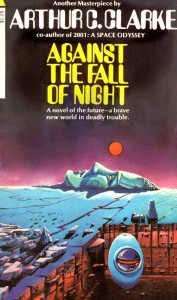 Clarke’s novel, originally written in 1953, is about a young man’s journey outside his protected city on a far-future Earth, long since devastated by an interplanetary war. There is no face in the story like the one on the cover—Walotsky, in the tradition of Powers, was embellishing—yet the whole novel is clearly on the same themes as the Face on Mars meme: the sublime contrast of ancient and futuristic, distance and intimacy, as well as dim memory of an ancient aeons-ago conflict. An ancient face gazing up at the stars seems to suggest a remnant of a civilization that once looked outward (and forward) but long since withdrew and stagnated.
Clarke’s novel, originally written in 1953, is about a young man’s journey outside his protected city on a far-future Earth, long since devastated by an interplanetary war. There is no face in the story like the one on the cover—Walotsky, in the tradition of Powers, was embellishing—yet the whole novel is clearly on the same themes as the Face on Mars meme: the sublime contrast of ancient and futuristic, distance and intimacy, as well as dim memory of an ancient aeons-ago conflict. An ancient face gazing up at the stars seems to suggest a remnant of a civilization that once looked outward (and forward) but long since withdrew and stagnated. Revitalizing human civilization after untold years of stagnation in some protected enclave or a global dark age is nearly as common a motif in SF as far journeying only to find one’s past, and the motifs are often found together. The end of Planet of the Apes or Logan’s Run come to mind here, of course. Walotsky died in 2002; whether he was precognizing the Face on Mars when he did his illustration or was simply inspired by somewhat similar images in then-recent SF, such as the Statue of Liberty on the beach in Planet of the Apes, is impossible to say.
But the more I delved into Walotsky and his life and work, the more interesting I found him. His work is full of images of masks, for one thing, and his most interesting fine-art works were real masks made from the shells of horseshoe crabs. He described that his initial inspiration for this series, which he called “Ancient Warriors of Lost Civilizations,” came from staring at one of these shells one day, and it appeared to him like a face—in other words, the same pareidolia that led people to see a face in an eroded Martian mesa.
 Walotsky honored this vision with his masks from the late 1980s up until his death, perhaps not consciously recalling the very real “source” for this idea that, as someone with a love of space and science fiction, he would undoubtedly have seen: Carl Sagan’s Cosmos series in 1980, specifically the segment in Episode Two about the Heike crabs of the Inland Sea in Japan. The 1185 battle of the Heike clan against the Genji clan was fought on the shores of this sea, and a species of crab with a wrinkled carapace occasionally produced specimens that seemed face-like. These were preferentially saved from the fishermen’s nets, tossed back into the water (fort-da again!) … and thus an inadvertent selective breeding, over the centuries, led to a prevalence of crabs with a samurai grimace, believed in folk tradition to be ghosts of the Heike warriors.
Walotsky honored this vision with his masks from the late 1980s up until his death, perhaps not consciously recalling the very real “source” for this idea that, as someone with a love of space and science fiction, he would undoubtedly have seen: Carl Sagan’s Cosmos series in 1980, specifically the segment in Episode Two about the Heike crabs of the Inland Sea in Japan. The 1185 battle of the Heike clan against the Genji clan was fought on the shores of this sea, and a species of crab with a wrinkled carapace occasionally produced specimens that seemed face-like. These were preferentially saved from the fishermen’s nets, tossed back into the water (fort-da again!) … and thus an inadvertent selective breeding, over the centuries, led to a prevalence of crabs with a samurai grimace, believed in folk tradition to be ghosts of the Heike warriors. The Heike crabs, with their warrior faces, are more than a bit like the Face on Mars—living monuments of an ancient destructive war. But these “ghosts” have also been shaped, sculpted, precisely by generations of human selection. There are no real ghosts, in other words, only a subtle and accelerated Darwinian process, abetted by pareidolia and forgetting—just as Walotsky may have seen and forgotten a fascinating/haunting segment in a PBS series and taken inspiration from it in his art.
Since it is only ever confirmed in hindsight, skeptics can always make a similar argument against the reality of precognition: It is the retrospective view on the past, inevitably reframed by salient events, that produces seeming prophecies, faces in the clouds of causality. The first task in the study of prophecy is establishing the extent to which our own activity in the present, scouring the past for precedents and selecting them out of a larger mass of irrelevancies, actually produces alleged coincidences instead of simply discovering them. When assessing Walotsky’s cover illustration for Against the Fall of Night, I lean toward “mere coincidence” rather than precognitive inspiration … but there is never any way to be sure.
NOTES
* Here’s a good example. One night in the Summer of 2013 (August 9, to be exact) I recorded in my dream diary: “hypnagogic vision of an old but crisp/unread paperback from the 70s about some esoteric science-fictioney topic, with a dark blue or black, orange, and red starburst cover.” The concentric colorful radiating circles suggested an explosion of light or perhaps consciousness; the next morning I went to my bookshelf to pull out an old pulp collection by Alfred Bester called Starburst, but the cover showed a moon of Mars and a rocket, nothing like in my vision.
 The very next day, on August 10, I was in an unfamiliar city, Providence, RI, on a trip with my wife’s family, and as I always do in new towns, I immediately gravitated to the used bookstores. Perusing the occult section of Paper Nautilus bookstore on South Angell Street, my eye fell on the black spine of The Roots of Coincidence by Arthur Koestler and I slid it out, astonished to find that it had nearly the exact cover I had seen on drifting to sleep two days before. The colors were slightly more dark and muted, and there was a small infinity symbol in the center that I had not seen; but otherwise it was the same concentric starburst design in the lower two thirds of an otherwise black cover, the same familiar 1970s paperback size and feel and smell and typography, and it was on precisely the somewhat science-fictional themes that were then obsessing me. (Although I knew Koestler’s reputation as a journalist on political topics, I was then unaware that the study of ESP and coincidences had dominated his interests during the last couple decades of his life.)
The very next day, on August 10, I was in an unfamiliar city, Providence, RI, on a trip with my wife’s family, and as I always do in new towns, I immediately gravitated to the used bookstores. Perusing the occult section of Paper Nautilus bookstore on South Angell Street, my eye fell on the black spine of The Roots of Coincidence by Arthur Koestler and I slid it out, astonished to find that it had nearly the exact cover I had seen on drifting to sleep two days before. The colors were slightly more dark and muted, and there was a small infinity symbol in the center that I had not seen; but otherwise it was the same concentric starburst design in the lower two thirds of an otherwise black cover, the same familiar 1970s paperback size and feel and smell and typography, and it was on precisely the somewhat science-fictional themes that were then obsessing me. (Although I knew Koestler’s reputation as a journalist on political topics, I was then unaware that the study of ESP and coincidences had dominated his interests during the last couple decades of his life.) Finding Koestler’s surprising book was quite a reward, and it proved to be a crucial touchstone for me in my thinking and writing about chance and coincidence. But more importantly, it was just the first of many examples of entropic images and symbols I would encounter in my near future, more often on the Internet (usually Twitter), that routinely catch the attention of my precognitive antennae. A picture merely suggesting a entropic event like an explosion is just as fascinating to the precognitive unconscious as a real one.
** Implicit in Zen’s “What was your original face?” is an invitation to make that face. Hint: We carry much of our stress, as well as much of what we are thinking or feeling, in our face. It produces a noticeable felt shift, a profound centering, just to become conscious of whatever grimace your face has hardened into and just “blanking” the face—erasing it of all expression, completely relaxing all facial muscles.
For some, the jury is still out on what the Face on Mars is. But all of it, the whole meme, including the uncertainty, should help solve the koan about your original face. Be like the face on Mars: ancient, impassive, alien, and empty—and possibly, no actual “face” at all.
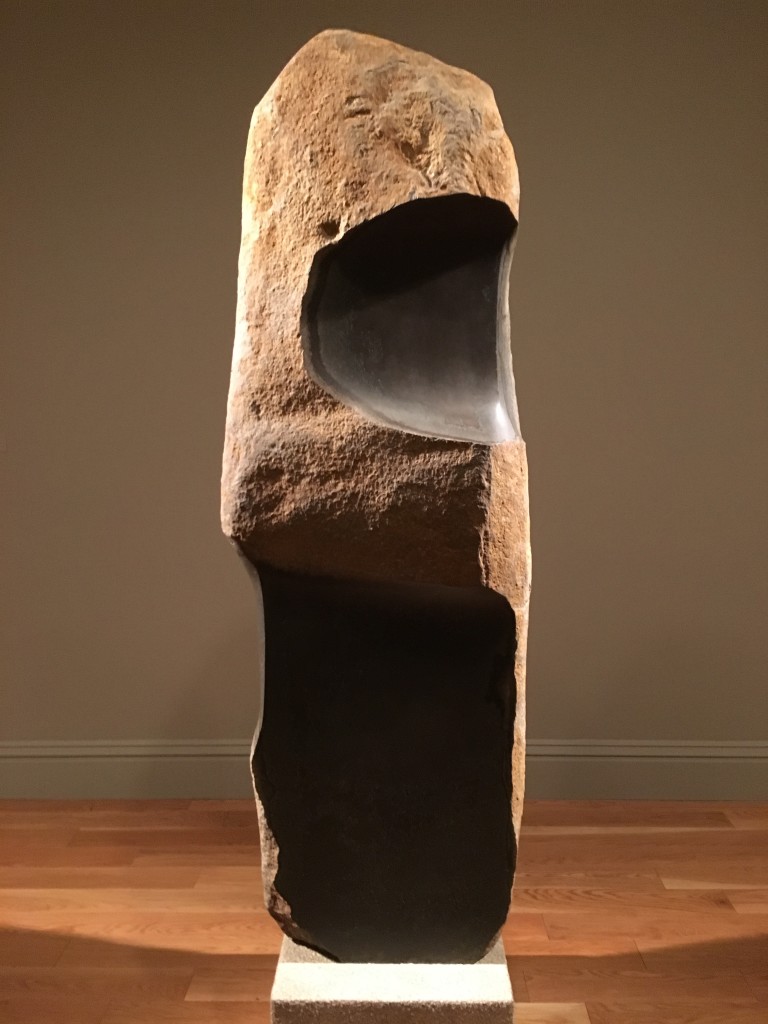
Thanks to Eric at: http://thenightshirt.com






 Sat Mar 23, 2024 11:33 pm by globalturbo
Sat Mar 23, 2024 11:33 pm by globalturbo

